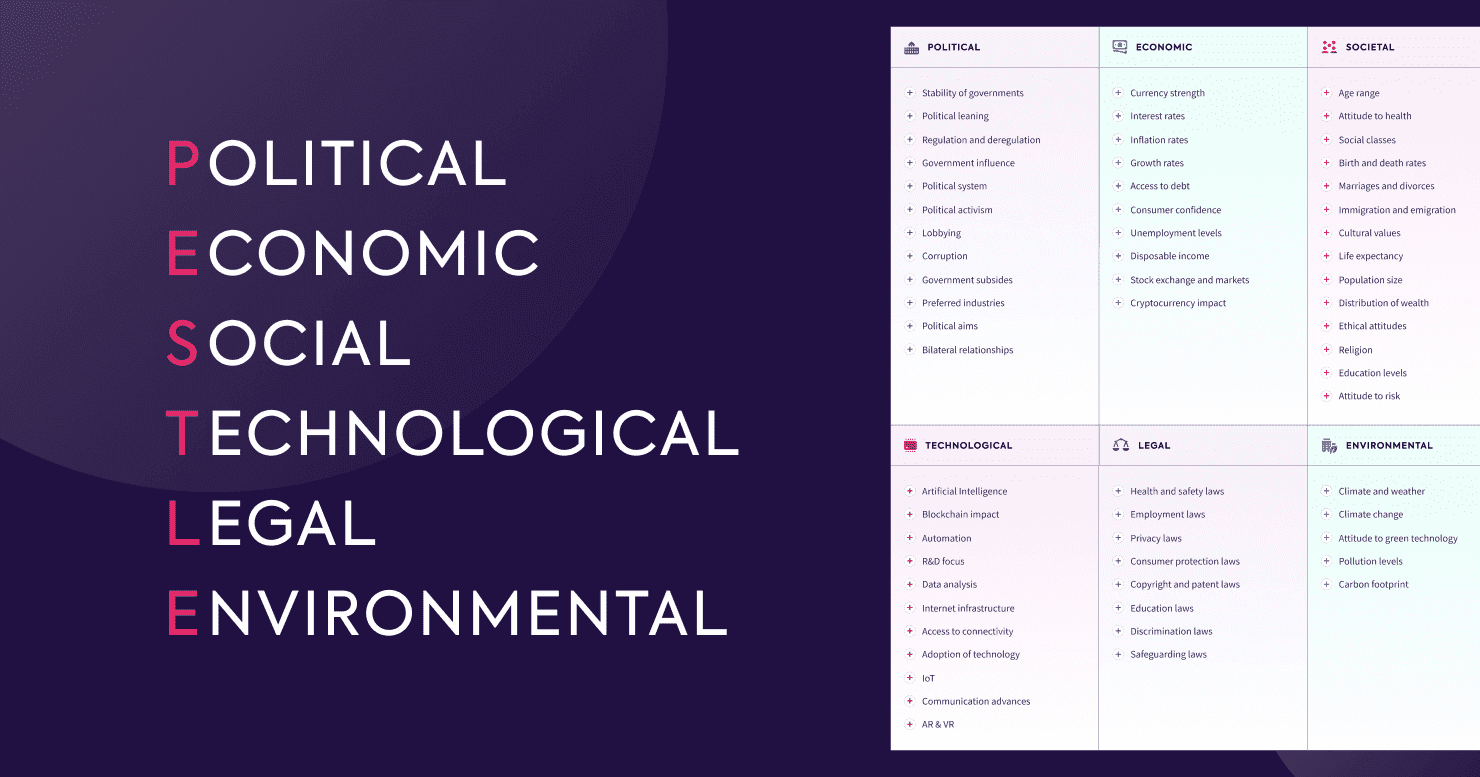PESTLE is a framework for exploring and listing the external factors that may impact your business and planning. PESTLE stands for Political, Economic, Social, Technological, Legal and Environmental.
There are a number of variations of PESTLE. You may see PEST, which is a shorter framework that doesn’t factor Environmental and Legal factors in the PESTLE analysis, or LoNGPESTLE, which factors geography into your analysis.
You may also see it sometimes spelt as PESTEL or posts talking about PESTEL analysis, which is the same as PESTLE in all but the ordering.
PESTLE remains the most popular framework for analysing the external issues a business may face due to the comprehensive but simplistic approach to looking at different areas.
We aim to be as comprehensive and simplistic in this guide, providing you with answers to the frequently asked questions, guides on how to develop your own framework, suggestions on toolkits to use and even a video. Let’s begin…
Beginner Guide to PESTLE
Link: An Introduction to PESTLE Analysis
If you’re new to PESTLE then this is an excellent starting point, answering all the common questions about the framework. It’s a detailed introductory guide to the model and provides the following information:
- Definition of PESTLE Analysis
- Example diagram
- Advantages and disadvantages
- Preparation and tips
- Background to the model
- Difference between PESTLE and LoNGPESTLE
- Advice around updating PESTLE
It’s the perfect starting article if you’re just getting to know the PESTLE model. We recommend you read it before the other resources in this ultimate guide. If you’ve heard of PESTLE before or you’ve used it, then you’ll likely find the resources below more useful.
Creating a PESTLE Analysis
Link: 5 Steps to creating a PESTLE Analysis
Completing your PESTLE is the perfect way to map out your external environment and doing it well can improve your other frameworks, such as SWOT. For example, your Opportunities may be larger than you expect when you’ve explored your external environment. This next resource is all about how to create a basic PESTLE, a PESTLE graph, or a PESTLE diagram, taking you through 6 steps to completing the full framework.
It includes:
- Step by step guide to building a PESTLE
- Example Political points
- Example Economic points
- Example Social points
- Example Technological points
- Example Legal points
- Example Environmental points
- Advice on refinement of your lists
- Helpful questions to ask at each section
- Quick wins on a PESTLE
- Ways to extend the PESTLE
If you’re starting from nothing then this is the perfect resource for you, and later in this guide we’ll touch on some templates and toolkits to make it an even easier process. Looking outside has never been simpler!
PESTLE Examples
There are many examples of PESTLE and they can be extremely helpful.
In some ways PESTLE is the best framework to complete using examples, as it focuses entirely on the wider environment, so many of the scenarios you find will relate to how your business operates. Take a look through these examples and consider which elements impact your own company.
The Body Shop:
Take a look at the factors that are in the PESTLE analysis for The Body Shop.
The Vegetarian Butcher:
An analysis of the factors impacting TVB, a plant based food producer.
Gymshark:
Looking at the analysis for a gym-wear business.
Leisure Centre:
Keeping the fitness theme, a look at the PESTLE for a Leisure Centre.
Gastropub:
Fitness theme ends here as we look at a set of issues impacting a Gastropub in the UK.
Finally, you can check out this case study on PESTLE for retail, which talks about the impact of the different PESTLE components for the retail sector. Remember, examples are important with a PESTLE as there will be elements of each analysis that you could likely pick out and put into your own version. You can find plenty more examples in our articles section, within Lucidity itself, or by Googling around…
PESTLE Toolkits
Now that you’ve seen more than one example of PESTLE analysis, we will look at toolkits.
Developing a PESTLE can be overwhelming. It’s a simple framework but requires a lot of thought and consideration, so picking the best approach to creating and storing your PESTLE is important. Here are some options…
Word, Excel & PowerPoint:
PESTLE doesn’t quite work as well as some of the 2×2 matrix in Word and PowerPoint. It tends to become a single slide per section or a large table over multiple pages. The best approach graphically is to run PESTLE as a 2×3 matrix or 6 pillars, this allows you to capture the data in a way you can see it all at once, as some of the areas will relate to each other, such as Political and Legal.
The advantages to running it in the Office packages is the speed to edit and share, but you will run into difficulty around consistency and getting employees and peers to engage with your work. It’s not the most inspiring of PESTLE approaches.
Whiteboard:
Although less popular since Covid, PESTLE done in a workshop will often be via whiteboards and sticky notes. It makes sense to break down PESTLE into different sections, allowing groups to take on their own areas and exchange information or present. This can be a more interactive and engaging way to craft a PESTLE, but you run the risk that once you type the notes up and file it, your PESTLE is long forgotten…
PESTLE Software:
Yes, hi there! We’re Lucidity 👋
Come on, we have to mention this one! In the Lucidity strategy software you can create your PESTLE by working through an easy to use wizard, and then store it within your strategic plan. Obviously the best way to do a PESTLE 👍
PESTLE Video Guide:
Link: How to do a PESTLE Analysis Video Guide
Do you prefer bitesize videos to full descriptive guides? Then this resource is just for you! We’ve put together a short video about PESTLE that gives you so much in so little time. In under 3 minutes you will be taken through:
- PESTLE Analysis definition
- Structure of a PESTLE
- Example Political factors
- Example Economic factors
- Example Social factors
- Example Technological factors
- Example of PESTLE Legal factors
- Example Environmental factors
- Refinement examples
Phew! Who needs Netflix! 📺
Full list of PESTLE Factors
If you need some help getting started here’s a starting list of PESTLE factors that should be thought about when you’re developing your own analysis.
Political
- Stability of governments
- Political leaning
- Regulation and deregulation
- Government influence
- Political system
- Political activism
- Lobbying
- Corruption
- Government subsides
- Preferred industries
- Political aims
- Bilateral relationships
Economic
- Currency strength
- Interest rates
- Inflation rates
- Growth rates
- Access to debt
- Consumer confidence
- Unemployment levels
- Disposable income
- Stock exchange and markets
- Cryptocurrency impact
Societal
- Age range
- Attitude to health
- Social classes
- Birth and death rates
- Marriages and divorces
- Immigration and emigration
- Cultural values
- Life expectancy
- Population size
- Distribution of wealth
- Ethical attitudes
- Religion
- Education levels
- Attitude to risk
Technological
- Artificial Intelligence
- Blockchain impact
- Automation
- R&D focus
- Data analysis
- Internet infrastructure
- Access to connectivity
- Adoption of technology
- IoT
- Communication advances
- AR & VR
Legal
- Health and safety laws
- Employment laws
- Privacy laws
- Consumer protection laws
- Copyright and patent laws
- Education laws
- Discrimination laws
- Safeguarding laws
Environmental
- Climate and weather
- Climate change
- Attitude to green technology
- Pollution levels
- Carbon footprint
PESTLE Tips and Advice
Here’s a couple of tips and advice on using PESTLE…
"One of the great aspects of PESTLE is it not only helps with strategic thinking, it can also help with marketing. Establishing the external factors affecting or impacting a business can lead into your messaging and campaigns."
Megan Saker
"The trick to doing a PESTLE isn’t what happens during the PESTLE, though it’s obviously important to be detailed. It’s about how you use the output. The information should impact your SWOT, your strategic decisions, and ultimately will impact your company performance."
Mike Fahey
"PESTLE is key, as being alert to external changes is vital to remain competitive and navigate with more ease in turbulent times"
Dr. Monica Masucci, Lecturer in Strategy and Innovation
"The real value in pestle is using it to identify Opportunities and Threats and therefore using it in conjunction with your SWOT. It should inform your SWOT. Using it in this way, you start to get some joined up thinking about what your strategy ought to be."
Tom Ricca-McCarthy
You can find more in our strategy tips guidebook.
Factoring Geography into PESTLE
Link: Introduction to LoNGPESTLE Analysis
There is a natural extension to PESTLE that is particularly key if you operate on a global level. It’s called LoNGPESTLE and helps you classify the different factors in a PESTLE by Local, National and Global categories. The ‘o’ was added just to make it sound better… though perhaps you could say it’s Orbital, if you sell in space? Seems unlikely though, so for the sake of this guide we’ll stick to LNG… 🌌
This article on LoNGPESTLE will take you through the following:
- Structure of a LoNGPESTLE
- Advantages and disadvantages
- Prework and considerations
LoNGPESTLE tends to be useful if you’re a larger company with a bigger set of data or if you operate internationally, otherwise often PESTLE can be extensive and helpful enough to get you the analysis you need.
PESTLE with a Demographic twist: DESTEP
Link: Guide to DESTEP Analysis
DESTEP Analysis stands for Demographic, Economic, Social, Technological, Ecological, Political/legal. As you can see it’s very similar to PESTLE, the difference being a stronger focus on Demographics and a lesser focus on Legals. This resource will answer all your key questions including:
- Definition of DESTEP
- Advantages and disadvantages
- Preparation and tips
Whether PESTLE or DESTEP is best for you depends largely on your business and which areas you wish to focus on.
PESTLE Variations
There’s a lot of variations of PESTLE going around. Here’s a quick round-up:
PEST
The original framework looking at Political, Economic, Social, Technological.
PESTLE
Hopefully we don’t need to define this one by now!
PESTEL
Same as PESTLE but spelt differently.
LoNGPESTLE
PESTLE with geographic categories.
SLEPT
Stands for Social, Legal, Economic, Political, Technological.
STEPE
Stands for Social, Technological, Economic, Political and Ecological.
STEEPLE
Stands for Social, Technological, Economic, Ethical, Political, Legal, Ecological.
DESTEP
Includes Demographics, Economic, Social, Technological, Environmental, Political.
STEEPLED
A combination of STEEPLE & DESTEP.
Summary
This concludes our guide to PESTLE in all its glory! We hope you’ve enjoyed it.
PESTLE remains one of the most popular frameworks due to it being a comprehensive approach to analysing the environment, staying alert to environmental regulations, and helping you make key strategic decisions. It absolutely works best to create a PESTLE hand in hand with a SWOT, so check out our guide to SWOT Analysis for everything you need to know on that.
Good luck mapping out the issues that impact you and making your business stronger for it! 💪
















